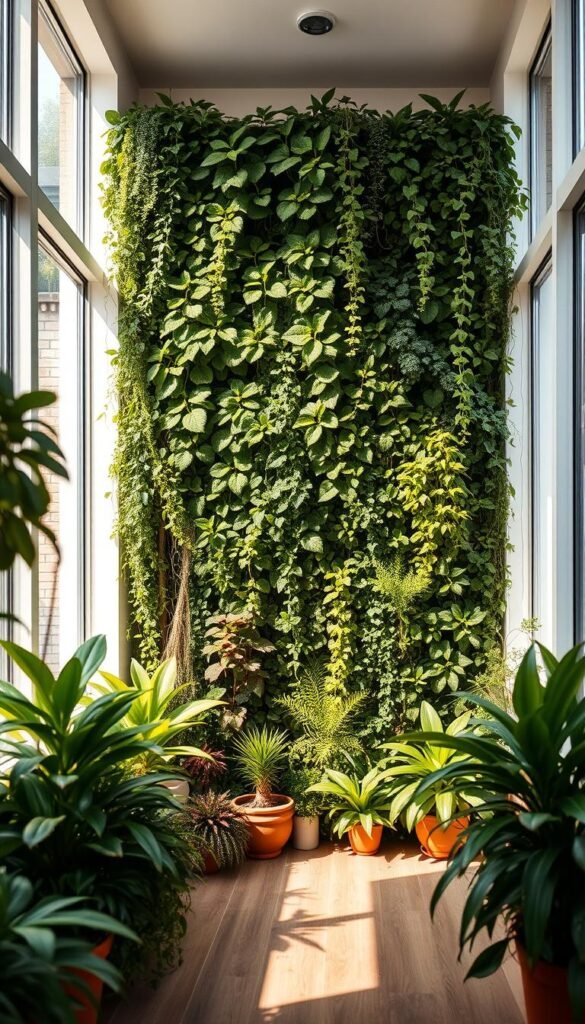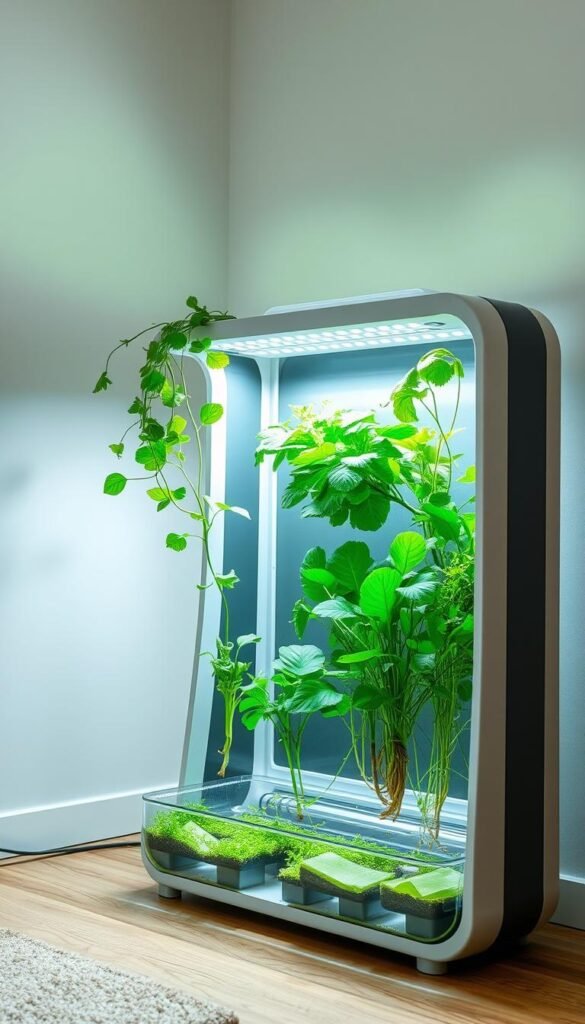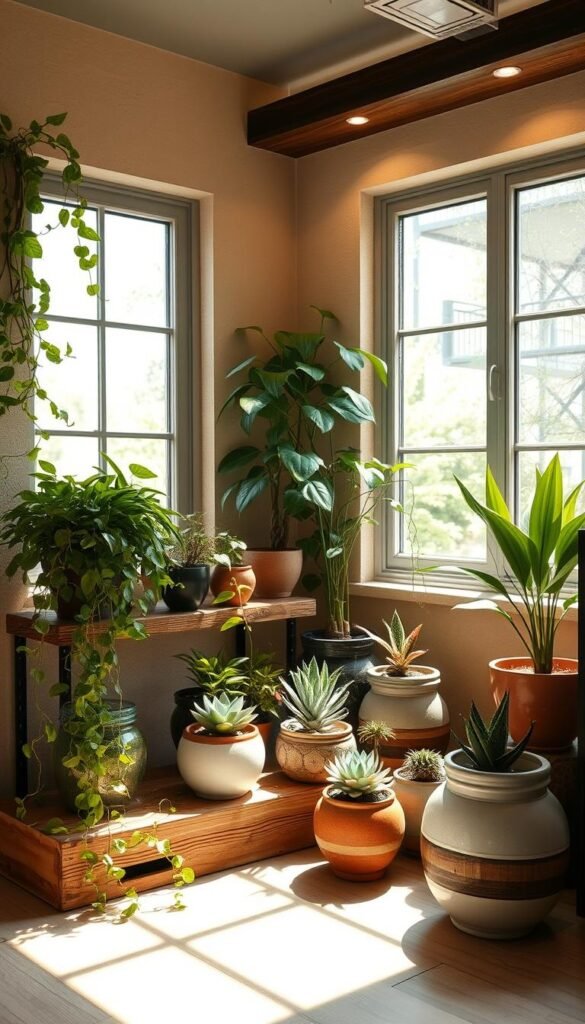Imagine transforming unused corners of your living area or workspace into lush, productive zones. Modern space-saving systems let you grow fresh herbs, crisp greens, and even colorful blooms without sacrificing square footage. Whether you’re in a studio apartment or a busy office, these solutions adapt to your unique environment.
Windowsill arrangements make perfect use of natural light, letting you harvest salad greens weekly. Vertical designs turn blank walls into cascading displays of vibrant greenery, while countertop hydroponic units use 90% less water than traditional methods. For those wanting dual benefits, compact aquaponic systems combine fishkeeping with plant cultivation in spaces no larger than a drum.
These setups do more than provide snacks—they purify air, boost mood, and create inviting atmospheres. You’ll see first sprouts within days and enjoy full harvests in weeks. The key lies in matching your lifestyle with the right combination of plants and technology.
Ready to turn that empty shelf or bare wall into a thriving ecosystem? Let’s explore how smart design and clever plant choices can make any area blossom with life.
Smart Planning for Small Spaces

Great green spaces begin with clever layouts. Start by sketching your room’s blueprint – note windows, furniture, and traffic patterns. South-facing windows work best for herbs like basil, while north-facing spots suit low-light plants like pothos.
Identifying key areas in your home or office
Track sunlight patterns using free apps like Sun Seeker. Morning light in east-facing zones nurtures mint and parsley. West-facing ledges handle afternoon heat for succulents. Don’t forget vertical spaces above cabinets or beside door frames – perfect for hanging containers.
Maximizing overlooked corners
Transform awkward nooks with triangular shelves or stackable pots. Bathrooms become tropical retreats with humidity-loving ferns. Try magnetic planters on fridge sides for fresh thyme. Floating shelves above radiators create warm microclimates for orchids.
Multi-use storage benches hide grow lights while offering seating. Corner ladder racks display cascading ivy without floor space. Remember: measure twice before installing wall-mounted solutions. Leave room for growth – seedlings become full-size plants quickly!
Maximizing Vertical Space in Your Indoor Garden

Walls become your secret weapon when floor space disappears. Vertical arrangements let you grow herbs, flowers, and leafy greens without cluttering surfaces. Wall-mounted systems turn blank surfaces into lush displays, combining practicality with visual appeal.
Vertical Planters and Modular Systems
Ready-made panels with planting pockets let you create instant green walls. These space-saving solutions hold 15-30 plants per square foot. Choose lightweight materials like felt or recycled plastic for easier installation. Always secure heavy setups to wall studs using toggle bolts.
| System Type | Best For | Plant Capacity |
|---|---|---|
| Modular Panels | Herbs & Succulents | 12-18 plants |
| Hanging Baskets | Trailing Varieties | 3-5 plants |
| Stackable Planters | Leafy Greens | 8-12 plants |
Crafting Custom Growing Solutions
Transform old materials into functional plant displays. Upcycled shoe organizers make perfect pockets for strawberries or thyme. Wooden pallets become instant herb racks when lined with landscape fabric. For quick hanging gardens, mount rain gutters under shelves to catch dripping water.
Group shade-tolerant ferns at the base of your vertical setup. Place sun-loving basil and rosemary near the top. Use drip irrigation kits or self-watering spikes to simplify maintenance. Your living wall will thrive with weekly checkups and monthly nutrient boosts.
Harnessing Natural Light for Optimal Growth

Mastering light management elevates your growing success. Sunlight fuels photosynthesis while shaping your plants’ health and productivity. Track how beams travel across rooms using free light meter apps or simple shadow observations.
Utilizing windows and reflective surfaces
South-facing windows become powerhouses for herbs and flowering varieties. Protect delicate leaves from summer scorch with adjustable blinds. North-facing areas suit peace lilies and snake plants craving softer illumination.
Boost dim corners with mirror panels behind shelves. Aluminum foil-lined boards redirect stray beams toward trailing pothos. White-painted walls act as natural amplifiers, especially in narrow spaces between furniture.
Tailoring your setup to different light conditions
Rotate pots weekly for even exposure. Create multi-level displays using staggered plant stands – tall specimens behind, compact varieties upfront. Thermal curtains help maintain stable temperatures during seasonal shifts.
Group shade-lovers like ferns on east-facing windowsills. Reserve west-facing ledges for jade plants and aloe that thrive in afternoon glow. Remember: light patterns change with seasons – move your garden setup accordingly!
Integrating Hydroponic and Aquaponic Systems

Modern growing methods let you cultivate fresh produce in spaces smaller than a broom closet. Water-based systems deliver nutrients directly to roots, cutting soil mess while boosting growth rates. These space-efficient solutions work on countertops, walls, or even inside repurposed containers.
Countertop hydroponic systems for compact areas
Start with a simple reservoir and air pump on your kitchen ledge. These low-maintenance setups grow basil and lettuce 50% faster than soil methods. You’ll harvest salad greens weekly without bending or digging.
Advanced models feature LED grow lights and automatic timers. Some fit 12 plants in 18-inch widths – perfect between coffee makers and toasters. Nutrients recirculate through the system, using 90% less water than traditional gardening.
Vertical and wall-mounted setups for water efficiency
Turn blank walls into edible displays with vertical towers. PVC pipe systems grow 30 leafy greens per square foot. Bamboo-based designs add natural texture while housing strawberry plants.
| System Type | Space Needed | Water Savings | Yield Potential |
|---|---|---|---|
| Countertop Hydroponics | 1 sq ft | 85-90% | 8-12 plants |
| Wall-Mounted Aquaponics | 2 sq ft | 95% | 15 plants + fish |
| Vertical NFT System | 4 sq ft | 90% | 25-30 plants |
Aquaponic systems take efficiency further by combining fish tanks with plant beds. A 55-gallon drum can yield tilapia and tomatoes simultaneously. Explore creative aquaponic setups that fit tight spaces while producing both protein and veggies.
These systems eliminate soil-borne pests and reduce harvest times. Roots access perfect nutrient blends 24/7, letting you enjoy crisp greens year-round. Whether you choose hydroponics or aquaponics, you’ll maximize yields in minimal areas.
Creative Container Gardening Solutions
Revolutionize your plant care with containers that work smarter, not harder. Modern designs blend functionality with style, letting you grow thriving greenery in unexpected places. From kitchen herbs to flowering displays, these space-savvy systems adapt to your routine.
Self-Watering Pots and Stackable Planters
Busy schedules meet their match with reservoirs that maintain perfect moisture for weeks. These containers use capillary action to prevent root rot – ideal for forgetful waterers. Pair them with lightweight soil mixes for vibrant growth without constant attention.
Build upward with modular towers that hold 12+ plants in 2 square feet. Try stacking units near sunny windows for basil or strawberries. Repurpose old colanders as quirky homes for succulents, or line baskets with plastic for portable herb gardens.
Don’t overlook vertical potential. Install window boxes bursting with cherry tomatoes and thyme – harvest while prepping meals. For visual impact, explore colorful arrangements combining textures like velvety sage and trailing ivy. Your creativity becomes the ultimate growing tool!






